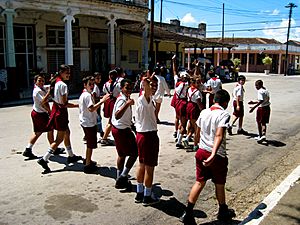Placetas facts for kids
Quick facts for kids
Placetas
|
||
|---|---|---|

OPJM pioneers in town center
|
||
|
||
| Nickname(s):
La Villa de los Laureles (Laurel City)
|
||

Placetas municipality (red) within
Villa Clara Province (yellow) and Cuba |
||
| Country | Cuba | |
| Province | Villa Clara | |
| Established | 1861 | |
| Incorporated | 1881 (town) | |
| 1925 (city) | ||
| Area | ||
| • Municipality | 601 km2 (232 sq mi) | |
| Elevation | 205 m (673 ft) | |
| Population
(2022)
|
||
| • Municipality | 65,379 | |
| • Density | 108.78/km2 (281.75/sq mi) | |
| • Urban | 19,894 | |
| • Rural | 45,485 | |
| Time zone | UTC-5 (EST) | |
| Area code(s) | +53-428 | |
| Highways | Carretera Central | |
Placetas (Spanish pronunciation: [plaˈsetas]) is a city located right in the middle of Cuba, in the Villa Clara Province. People often call it La Villa de los Laureles, which means "Laurel City," because of the many wild laurel trees growing there. Placetas is also a municipio, which is like a local government area, and it's one of 13 such areas in the Villa Clara Province. Did you know that the very center of Cuba, a place called Guaracabulla, is found in this municipality?
Contents
History of Placetas
Placetas was first started on September 9, 1861. It grew mainly because of the sugar industry. Today, the area is known for growing a lot of tobacco. A Spanish Marques and former army colonel named Jose Martinez-Fortun y Erles helped a lot in founding the town.
Growth and Development of Placetas
The town is located on the Carretera Central road, which is a big highway that goes through the town. Being on this road made Placetas a popular stop for many travelers. Placetas has grown a lot over the years. It was officially called a town in 1881 and then a city in 1925. In 1879, it became its own municipality, meaning it had its own local government.
Local Celebrations in Placetas
Placetas is also famous for its exciting carnivals. These big celebrations happen in July and around Christmas and New Year's Eve. Until the 1990s, different neighborhoods, called barrios, used to have their own special celebrations to show their local pride.
Geography of Placetas
Placetas is located in the southwest part of its province. It is close to the border of the Sancti Spíritus Province.
Neighboring Towns and Rivers
Nearby towns include Zulueta to the north and Remedios to the northeast. To the east, you'll find Cabaiguán and Fomento. To the west are Santa Clara and Camajuaní. The Zaza River starts near Placetas and flows to the sea. This river area is now protected to keep its environment safe.
Villages in Placetas Municipality
The municipality of Placetas shares its borders with Manicaragua, Santa Clara, Camajuaní, Remedios, Cabaiguán, and Fomento. Inside its area, you can find several villages. These include Báez, Benito Juárez, Carbó Serviá, Falcón, Falero, Guaracabulla, Hermanos Ameijeiras, Manzanares, Máximo, Miller, Nazareno, Oliver, and Suazo.
Population and Demographics
In 2022, the municipality of Placetas had a total population of 65,379 people. The city itself had about 42,000 residents. The total area of the municipality is 601 square kilometers (about 232 square miles). This means there are about 119.5 people living in each square kilometer.
Economy and Industries
Historically, Placetas was a big sugar producing area. It had three large sugar factories called "centrales." The city also had important railroad industries.
Modern Economy and Commerce
Many people from Placetas have moved to other countries, especially the United States. About 2,300 people from Placetas live in the United States, with most of them in Miami. This means many people travel back to Placetas from the United States each month. Today, Placetas is also known for its many aluminum factories. It's even called the "capital of aluminum" in Cuba because of its export business.
Main Streets and Tourism
One of the main streets in Placetas is Primera del Oeste street. This street is where Cuba's central road meets Parque Casallas. It's home to Rumbos, a popular place for tourists that opened recently. This street is also a center for local businesses. People in Placetas sometimes call it "La Calle 8 de Placetas," which is a reference to 8th Street in Miami.
Architecture and Public Buildings
The main Catholic church in Placetas is called San Atanasio de Placetas. It is named after the town's patron saint.
Community Facilities
As of 1996, Placetas had a library, a central post office, and three middle-high schools. These schools were named 13 de Marzo, Rodolfo Leon Perlacia, and Julio Antonio Mella. The town also had a police station and many places for recreation. Most of the buildings in the downtown area were built before 1959. Not many of the town's older buildings have been updated since then.
Notable People from Placetas
- Miguel Díaz-Canel (born 1960), who became the President of Cuba in 2018.
- Pepin Garcia (born 1950), a Cuban-American businessman.
- Emilio Mola (1887-1937), a Spanish general who helped start the Spanish Civil War.
- La Chelito (1885–1959), a Cuban-born Spanish singer from the early 1900s.
- Alberto Rojas Espinoza (1868-1912), a colonel in the Cuban Liberation Army during Cuba's fight for independence from Spain in 1895. He also served as the mayor of the municipality in 1901 and 1912.
Images for kids
See also
 In Spanish: Placetas para niños
In Spanish: Placetas para niños




